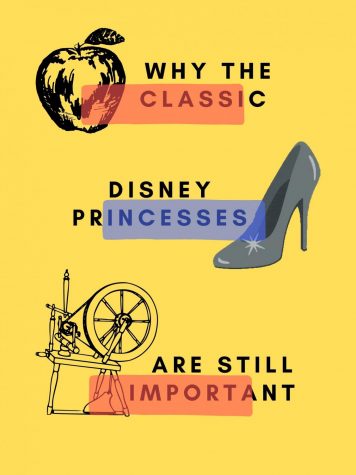Why The Classic Disney Princesses Are Still Important
Taking a deeper look at 3 princesses and why they are still a good role models
December 17, 2020

Chances are, you grew up with Disney when you were little, gliding through fairytale after fairytale, grooving out to the soundtrack and discovering your favorite characters. Recently, the classic Disney princesses, Snow White, Cinderella and Aurora have come under fire for being too submissive and giving the wrong message to kids.
Disney is starting to bring variety when it comes to their princesses, taking back the old tropes like falling in love with a prince. While many of the themes of their movies include being kind, their stories are much more than falling in love. This requires a deeper look to actually learn what the stories are trying to teach.
On the surface of their stories, it’s very clear that these characters were made in a time where a woman’s only duty was to their home. But through their kindness and compassion, they are a lot stronger than we think of them.
If we look at Snow White, we can see traits such as charitability, responsibility and trust. It may be hard to see it since everything is covered up by the stereotypes of women at the time, but Snow Whites’ struggle is with her stepmother. Snow White is a good example of community service. While she does clean the cottage, she doesn’t know people live there, and even when the dwarves do meet her she teaches them how to take care of themselves. And another trait that Snow White carries is that she doesn’t let her status of being a princess stop her from treating others as equals.
Taking a look at Cinderella—she’s come under lots of fire taking in her situation of becoming submissive to her stepmother. Her movie has been criticized for teaching young girls to accept abuse, but this isn’t true. We see throughout the movie Cinderella remains kind to her stepsisters and stepmother. She doesn’t engage in fighting (whether that be physically or verbally) or try to escape. Her kindness is what saves her throughout the whole story and helps her survive.
Like when her fairy godmother comes, that’s Cinderella manifesting her after she’s hit rock bottom. Her fairy godmother even says “You haven’t lost all your faith, if you did, I wouldn’t be here.” The movie isn’t about her falling in love with the prince. It’s about Cinderella’s just reward, her added bonus, for being kind, having grit, and being resourceful. It’s a way for her stepsisters and stepmother to see that being a good person can get you farther in life than just abusing your way to the top.
Last but not least we have Aurora, otherwise known as Sleeping Beauty. Now, Aurora doesn’t get that much screen time—in fact, she only has 18 speaking lines. While she does have a prince save her, her story doesn’t really revolve around the prince. What she wants is a friend, someone to talk to. She exists more as a concept idea than a complex character. But even with that, kids can recognize her traits of being gentle, kind, and trustworthy, just the same.
There’s no denying that these characters have been diluted because of the barriers their gender posed during the time period they were portrayed. But to say that the classic Disney princesses are bad or aren’t worthy of their role model status compared to the more modern princesses is wrong, and in some way oversimplifying these characters and their stories.












